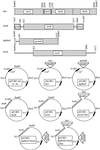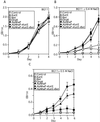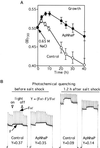Overexpression of a Na+/H+ antiporter confers salt tolerance on a freshwater cyanobacterium, making it capable of growth in sea water
- PMID: 11891307
- PMCID: PMC122656
- DOI: 10.1073/pnas.052576899
Overexpression of a Na+/H+ antiporter confers salt tolerance on a freshwater cyanobacterium, making it capable of growth in sea water
Abstract
The salt tolerance of a freshwater cyanobacterium, Synechococcus sp. PCC 7942, transformed with genes involved in the synthesis of a Na(+)/H(+) antiporter, betaine, catalase, and a chaperone was examined. Compared with the expression of betaine, catalase, and the chaperone, the expression of the Na(+)/H(+) antiporter gene from a halotolerant cyanobacterium (ApNhaP) drastically improved the salt tolerance of the freshwater cyanobacterium. The Synechococcus cells expressing ApNhaP could grow in BG11 medium containing 0.5 M NaCl as well as in sea water, whereas those expressing betaine, catalase, and the chaperone could not grow under those conditions. The coexpression of ApNhaP with catalase or ApNhaP with catalase and betaine did not further enhance the salt tolerance of Synechococcus cells expressing ApNhaP alone when grown in BG11 medium containing 0.5 M NaCl. Interestingly, the coexpression of ApNhaP with catalase resulted in enhanced salt tolerance of cells grown in sea water. These results demonstrate a key role of sodium ion exclusion by the Na(+)/H(+) antiporter for the salt tolerance of photosynthetic organisms.
Figures





Similar articles
-
Halotolerant cyanobacterium Aphanothece halophytica contains NapA-type Na+/H+ antiporters with novel ion specificity that are involved in salt tolerance at alkaline pH.Appl Environ Microbiol. 2005 Aug;71(8):4176-84. doi: 10.1128/AEM.71.8.4176-4184.2005. Appl Environ Microbiol. 2005. PMID: 16085800 Free PMC article.
-
Halotolerant cyanobacterium Aphanothece halophytica contains a betaine transporter active at alkaline pH and high salinity.Appl Environ Microbiol. 2006 Sep;72(9):6018-26. doi: 10.1128/AEM.00733-06. Appl Environ Microbiol. 2006. PMID: 16957224 Free PMC article.
-
Halotolerant cyanobacterium Aphanothece halophytica contains an Na(+)/H(+) antiporter, homologous to eukaryotic ones, with novel ion specificity affected by C-terminal tail.J Biol Chem. 2001 Oct 5;276(40):36931-8. doi: 10.1074/jbc.M103650200. Epub 2001 Jul 30. J Biol Chem. 2001. PMID: 11479290
-
[Genetic control and mechanisms of salt and hyperosmotic shock resistance in cyanobacteria].Genetika. 2005 Dec;41(12):1589-600. Genetika. 2005. PMID: 16396444 Review. Russian.
-
Engineering salt tolerance of photosynthetic cyanobacteria for seawater utilization.Biotechnol Adv. 2020 Nov 1;43:107578. doi: 10.1016/j.biotechadv.2020.107578. Epub 2020 Jun 15. Biotechnol Adv. 2020. PMID: 32553809 Review.
Cited by
-
Roles of NhaA, NhaB, and NhaD Na+/H+ antiporters in survival of Vibrio cholerae in a saline environment.J Bacteriol. 2003 Feb;185(4):1236-44. doi: 10.1128/JB.185.4.1236-1244.2003. J Bacteriol. 2003. PMID: 12562793 Free PMC article.
-
Functional expression of Sinorhizobium meliloti BetS, a high-affinity betaine transporter, in Bradyrhizobium japonicum USDA110.Appl Environ Microbiol. 2004 Oct;70(10):5916-22. doi: 10.1128/AEM.70.10.5916-5922.2004. Appl Environ Microbiol. 2004. PMID: 15466533 Free PMC article.
-
Halotolerant cyanobacterium Aphanothece halophytica contains NapA-type Na+/H+ antiporters with novel ion specificity that are involved in salt tolerance at alkaline pH.Appl Environ Microbiol. 2005 Aug;71(8):4176-84. doi: 10.1128/AEM.71.8.4176-4184.2005. Appl Environ Microbiol. 2005. PMID: 16085800 Free PMC article.
-
Identification of a Halotolerant Mutant via In Vitro Mutagenesis in the Cyanobacterium Fremyella diplosiphon.Curr Microbiol. 2017 Jan;74(1):77-83. doi: 10.1007/s00284-016-1156-z. Epub 2016 Nov 14. Curr Microbiol. 2017. PMID: 27844126
-
A Synechococcus elongatus PCC 7942 mutant with a higher tolerance toward the herbicide bentazone also confers resistance to sodium chloride stress.Photosynth Res. 2007 Apr;92(1):87-101. doi: 10.1007/s11120-007-9176-y. Epub 2007 Jun 7. Photosynth Res. 2007. PMID: 17554635
References
-
- Zhu J-K. Trends Plant Sci. 2001;6:66–71. - PubMed
-
- Kempf B, Bremer E. Arch Microbiol. 1998;170:319–330. - PubMed
-
- Serrano R, Rodriguez-Navarro A. Curr Opin Cell Biol. 2001;13:399–404. - PubMed
-
- Asada K. Annu Rev Plant Physiol Plant Mol Biol. 1999;50:601–639. - PubMed
-
- Apse M P, Aharon G S, Snedden W A, Blumwald E. Science. 1999;285:1256–1125. - PubMed
Publication types
MeSH terms
Substances
LinkOut - more resources
Full Text Sources
Other Literature Sources

